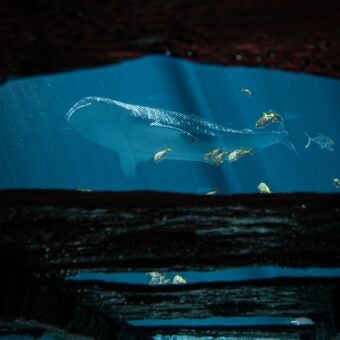-
Size
18 feet (5.5 m) -
Diet
Slow schooling fishes -
Range
Indo-West Pacific -
Habitat
Found in shallow bays, lagoons and estuaries
Physical Characteristics
- Common length of 18 feet (5.5 m), with a maximum length of 24 feet (7 m).
- Heavy, shark like body; very flat on ventral side.
- Long, narrow rostrum is common to all sawfish. In this species, the “saw” is the longest of all, reaching a maximum length of 5 feet (1.5 m).
- Typically has 25-34 rostral teeth (actually modified dermal denticles) on either side of the saw.
- Displays countershading; dark olive or grey on the dorsal side and pale yellow or white underneath.
Animal Fact
The longcomb sawfish’s “saw” or rostrum can be as long as 5 feet (1.5 m).
Diet / Feeding
- Diet consists primarily of slow schooling fishes, such as mullet.
- The longcomb sawfish will use its rostrum to help it hunt or forage for food. It will first swim alongside its prey and then strike it with a sudden swipe of its toothed rostrum. This sawfish may also use its rostrum to stir up the sandy bottom to find bottom-dwelling crustaceans and shellfish.
Range / Habitat
- Occurs in the Indo-West Pacific, Australia and Papua New Guinea, eastern coast of Africa and the Red Sea, as well as China and New South Wales.
- Mainly bottom-dwelling and found in shallow bays, lagoons and estuaries. Has been found at depths up to 130 feet (40 m), but 1-16 feet (0.3-5 m) seems to be most common.
Reproduction & Growth
- Ovoviviparous- eggs are hatched internally.
- Reaches maturity after 9 years.
- Females can have litters of approximately 12 pups.
Conservation Status
- “Critically Endangered” on the IUCN Red List.
Additional Information
- Also known as the “green” sawfish and the “narrow snout” sawfish.
- Vulnerable to nets; both fishing and shark control nets surrounding beaches.
- Predators include tiger and bull sharks, as well as freshwater crocodiles.
- It has been suggested (Grant, 1978) that adult males will use their saws in dominance and mating battles.





